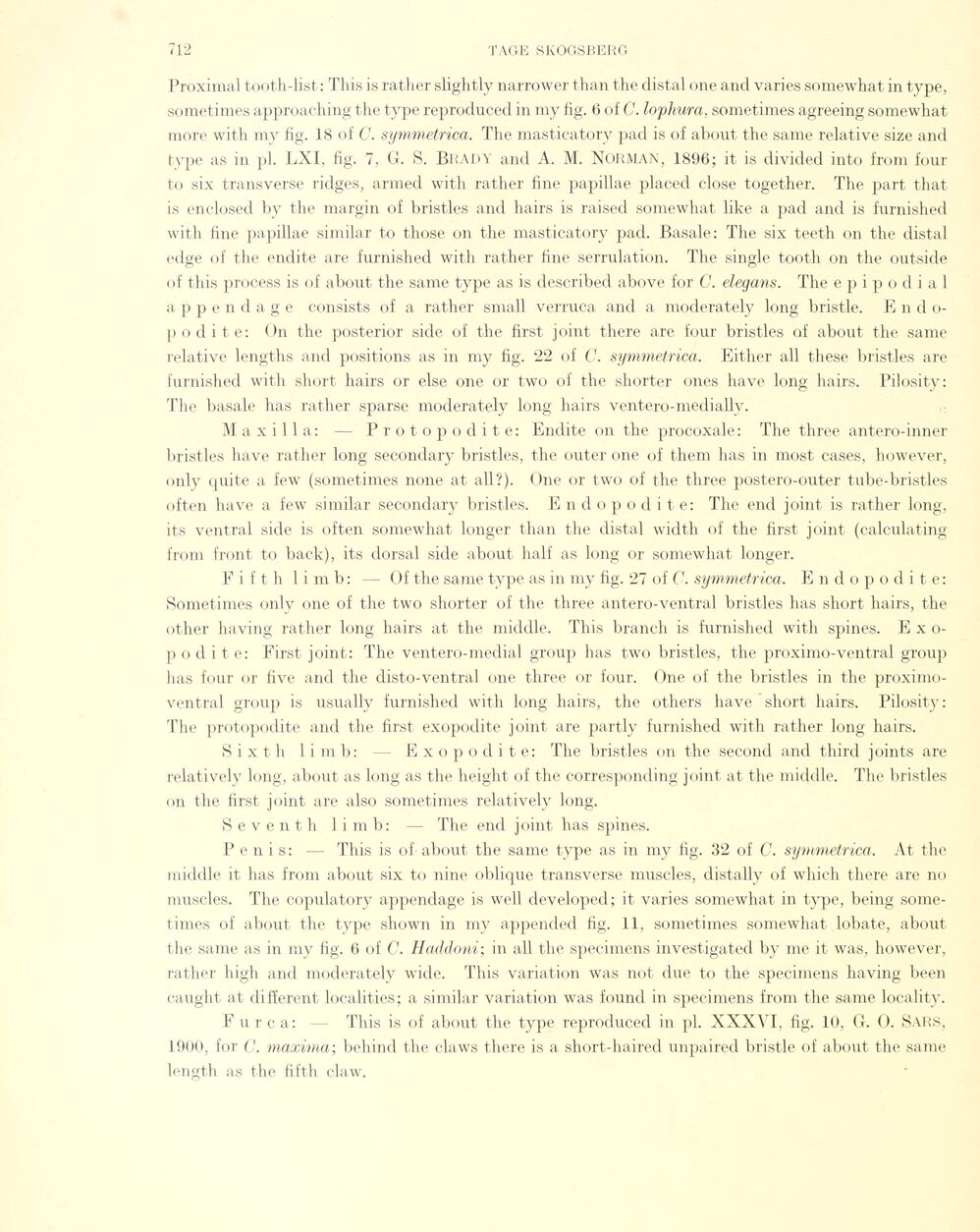
Full resolution (JPEG) - On this page / på denna sida - Sidor ...

<< prev. page << föreg. sida << >> nästa sida >> next page >>
Below is the raw OCR text
from the above scanned image.
Do you see an error? Proofread the page now!
Här nedan syns maskintolkade texten från faksimilbilden ovan.
Ser du något fel? Korrekturläs sidan nu!
This page has never been proofread. / Denna sida har aldrig korrekturlästs.
Proximal tooth-list: This is ratlier slightly narrower than the distal one and varies somewhat in type,
sometimes approaching the type reproduced in my fig. 6 of C. lophura, sometimes agreeing somewhat
more with my fig. 18 of C. symmetrica. The masticatory pad is of about the same relative size and
type as in pi. LXI, fig. 7, G. S. BRADY and A. M. NORMAN, 1S96; it is divided into from four
to six transverse ridges, armed with rather fine papillae placed close together. The part that
is enclosed by the margin of bristles and hairs is raised somewhat like a pad and is furnished
with fine papillae similar to those on the masticatory pad. Basale: The six teeth on the distal
edge of the endite are furnished with rather fine serrulation. The single tooth on the outside
of this process is of about the same type as is described above for C. elegans. The epipodial
appendage consists of a rather small verruca and a moderately long bristle. E n d
o-p o di te: On the posterior side of the first joint there are four bristles of about the same
relative lengths and positions as in my fig. 22 of C. symmetrica. Eitlier all these bristles are
furnished with short hairs or else one or two of the shorter ones have long hairs. Pilosity:
The basale has rather sparse moderately long hairs ventero-medially.
Maxilla: — Protopo di te: Endite on the procoxale : The three antero-inner
bristles have rather long secondary bristles, the outer one of them has in most cases, however,
only quite a few (sometimes none at all?). One or two of the three postero-outer tube-bristles
often have a few similar secondary bristles. Endopodite: The end joint is rather long,
its ventral side is often somewhat longer than the distal width of the first joint (calculating
from front to back), its dorsal side about half as long or somewhat longer.
Fift.h limb: — Of the same type as in my fig. 27 of C. symmetrica. Endopodite:
Sometimes only one of the two shorter of the three antero-ventral bristles has short hairs, the
other having rather long hairs at the middle. This brauch is furnished with spines.
Exo-p odite: First joint: The ventero-medial group has two bristles, the proximo-ventral group
has four or five and the disto-ventral one three or four. One of the brist-les in the
proximo-ventral group is usually furnished with long hairs, the others have short hairs. Pilosity:
The protopodite and the first exopodite joint are partly furnished with rather long hairs.
S i X t h limb: — Exopodite: The bristles on the second and third j oints are
relati vely long, about as long as the height of the corresponding joint at the middle. The brist-les
on the first joint are also sometimes relatively long.
S e v e n t h limb: — The end joint bas spines.
Penis: — This is of about the same type as in my fig. 32 of C. symmetrica. At the
middle it has from about six to nine oblique transverse muscles, distally of which there are no
muscles. The copulatory appendage is well developed; it varies somewhat in type, being
sometimes of about the type shown in my appended fig. 11, sometimes somewhat lobate, about
the sanie a-s in ray fig. 6 of C. Haddoni; in ail the specimens investigated by me it was, however,
rather high and moderately wide. This variation was not due to the specimens having been
caught at different, localities; a similar variation was found in specimens from the same locality.
F u rca: — This is of about the type reproduced in pi. XXXYI, fig. 10, G. O. SARS,
1900, for C. maxima; behind the claws there is a short-haired unpaired bristle of about the same
lengt-h as the fifth claw.
<< prev. page << föreg. sida << >> nästa sida >> next page >>